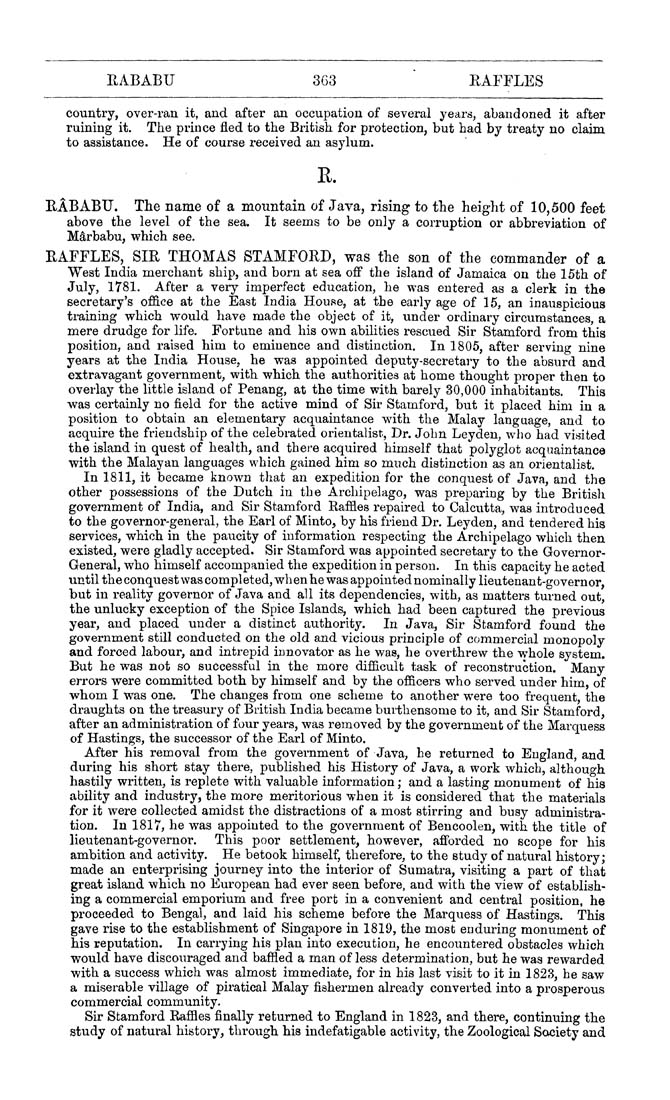RABABU 363 RAFFLES
country, over-ran it, and after an occupation of several years, abandoned it after
ruining it. The prince fled to the British for protection, but had by treaty no claim
to assistance. He of course received an asylum.
R.
RABABU. The name of a mountain of Java, rising to the height of 10,500 feet
above the level of the sea. It seems to be only a corruption or abbreviation of
Mdrbabu, w^hich see.
RAFFLES, SIR THOMAS STAMFORD, was the son of the commander of a
West India merchant ship, and born at sea off the island of Jamaica on the 15th of
July, 1781. After a very imperfect education, he was entered as a clerk in the
secretary's office at the East India House, at the early age of 15, an inauspicious
training which would have made the object of it, under ordinary circumstances, a
mere drudge for life. Fortune and his own abilities rescued Sir Stamford from this
position, and raised him to eminence and distinction. In 1805, after serving nine
years at the India House, he was appointed deputy-secretary to the absurd and
extravagant government, with which the authorities at home thought proper then to
overlay the little island of Penang, at the time with barely 30,000 inhabitants. This
was certainly no field for the active mind of Sir Stamford, but it placed him in a
position to obtain an elementary acquaintance wdth the Malay language, and to
acquire the friendship of the celebrated orientalist, Dr. John Leyden, who had visited
the island in quest of health, and there acquired himself that polyglot acquaintance
with the Malayan languages which gained him so much distinction as an orientalist.
In 1811, it became known that an expedition for the conquest of Java, and the
other possessions of the Dutch in the Archipelago, was preparing by the British
government of India, and Sir Stamford Raffles repaired to Calcutta, was introduced
to the governor-general, the Earl of Minto, by his friend Dr. Leyden, and tendered his
services, which in the paucity of information respecting the Archipelago whicli then
existed, were gladly accepted. Sir Stamford was appointed secretary to the Governor-
General, who himself accompanied the expedition in person. In this capacity he acted
until the conquest was completed, when he was appointed nominally lieutenant-governor,
but in reality governor of Java and all its dependencies, with, as matters turned out,
the unlucky exception of the Spice Islands, which had been captured the previous
year, and placed under a distinct authority. In Java, Sir Stamford found the
government still conducted on the old and vicious principle of commercial monopoly
and forced labour, and intrepid innovator as he was, he overthrew the whole system.
But he was not so successful in the more difficult task of reconstruction. Many
errors were committed both by himself and by the oflScers who served under him, of
whom I w^as one. The changes from one scheme to another were too frequent, the
draughts on the treasury of British India became burthensome to it, and Sir Stamford,
after an administration of four years, was removed by the government of the Marquess
of Hastings, the successor of the Earl of Minto.
After his removal from the government of Java, he returned to England, and
during his short stay there, published his History of Java, a work which, although
hastily written, is replete with valuable information; and a lasting monument of his
ability and industry, the more meritorious when it is considered that the materials
for it were collected amidst the distractions of a most stirring and busy administra¬
tion. In 1817, he was appointed to the government of Bencoolen, with the title of
lieutenant-governor. This poor settlement, however, afforded no scope for his
ambition and activity. He betook himself, therefore, to the study of natural history;
made an enterprising journey into the interior of Sumatra, visiting a part of that
great island which no European had ever seen before, and with the view of establish¬
ing a commercial emporium and free port in a convenient and central position, he
proceeded to Bengal, and laid his scheme before the Marquess of Hastings. This
gave rise to the establishment of Singapore in 1819, the mosfc enduring monument of
his reputation. In carrying his plan into execution, he encountered obstacles which
would have discouraged and baffled a man of less determination, but he was rewarded
with a success which was almost immediate, for in his last visit to it in 1823, he saw
a miserable village of piratical Malay fishermen already converted into a prosperous
commercial community.
Sir Stamford Raffles finally returned to England in 1823, and there, continuing the
study of natural history, through his indefatigable activity, the Zoological Society and
|








